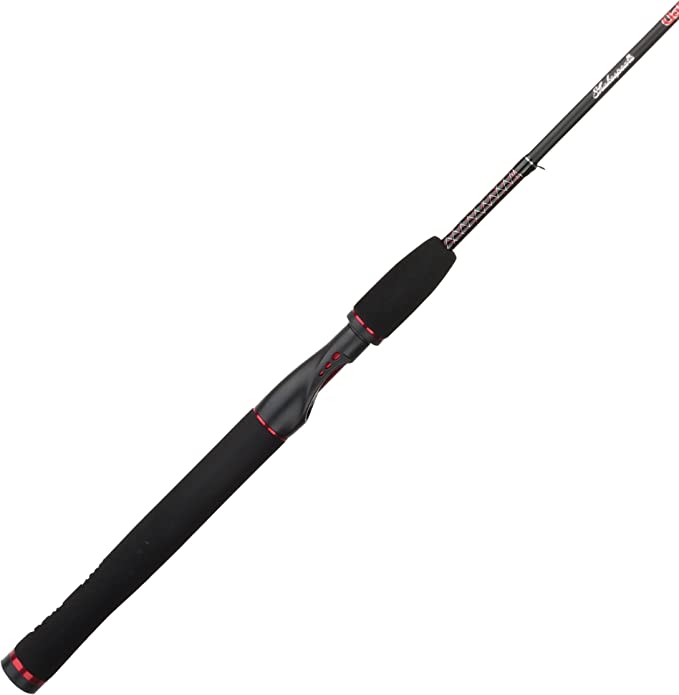The $41.99 Question: Is the BERRYPRO EB602S the Best of the 'Cheap Spinning Rods' for Performance?
Update on Dec. 9, 2025, 3:02 p.m.
The quest for truly sensitive fishing equipment often collides with the reality of a budget. When scouting for cheap spinning rods under the $50 mark, anglers typically expect to compromise on feel, power, or, most often, the materials. The BERRYPRO EB602S Spinning Rod challenges this expectation. It boldly incorporates features reserved for premium gear: a Full 30-Ton carbon fiber blank reinforced with X-Carbon technology. This combination is engineered for lightness, slim profiles, and incredible sensitivity. But the question remains: Can a sub-$50 rod handle the stress, or is the high-performance material too fragile for the price tag?
The High-Modulus Dilemma: Why ‘Sensitive’ Can Mean ‘Fragile’
The core science behind the EB602S is its 30-Ton carbon fiber construction. This “Ton” rating, which denotes the material’s stiffness (tensile modulus), is the key to its sensitivity. Higher modulus blanks require less material to achieve the desired stiffness, resulting in an incredibly thin and light rod that effortlessly transmits the subtle “taps and bumps” of a fish bite.
However, high modulus blanks come with a trade-off: brittleness. The stiffer the carbon fiber, the more prone it is to breakage from impact or high-angle stress—a notorious problem among many cheap carbon rods. Our own research into user reviews confirms a recurring pain point: the tip broke critique.
User Voice: “10/25- tip broke, I’m not really sure how. Broke while retrieving, not setting a hook or anything.”
This feedback, though negative at first glance, highlights the structural risk inherent in maximizing sensitivity at a low cost. It’s a design compromise that demands proper maintenance and handling.

The X-Carbon Reinforcement: Mitigating Structural Failure
To combat the inherent fragility of high-modulus material, BERRYPRO implemented its X-Carbon technology. This cross-wrap reinforcement acts as an external lattice, dramatically increasing the blank’s hoop strength.
- During the Cast: The wrap prevents the hollow, slender blank from collapsing into an oval shape (ovalization), ensuring your casting energy is transferred into linear distance and accuracy.
- During the Fight: It provides a critical layer of defense against shock stress, particularly when fighting powerful bass or pulling a lure from heavy cover (as noted by users successfully fighting fish out of “heavy lilly pads”).
While the X-Carbon doesn’t make the rod indestructible, it’s a structural feature rarely seen on cheap spinning rods, showcasing a commitment to engineering beyond the bare minimum.
The Ultimate Risk Management: BERRYPRO’s One Year Warranty
For budget-conscious anglers, the true competitive edge of the EB602S is not just its performance, but the company’s powerful One Year Warranty.
The user reviews, while mentioning breakage, pivot quickly to praise the manufacturer’s response:
User Voice: “Manufacturer stands by their product and sent me a new rod. No imperfections at all.”
This is the hidden value proposition. A low-cost, high-performance carbon rod is a risky purchase, but BERRYPRO transforms that risk into peace of mind. The warranty acts as your insurance policy, effectively turning the $41.99 rod into a guaranteed one-year investment in performance. For anyone seeking one of the best performing cheap spinning rods available, this excellent customer service response is as critical as the Stainless steel guides with ceramic ring (which ensure smooth line movement and excellent vibration transfer) or the comfortable Cork handle.
When assessing the market for cheap spinning rods, the BERRYPRO EB602S emerges as a leader not just for the what (30-Ton carbon), but for the how (X-Carbon tech and a reliable warranty). It delivers premium features without the premium price, and backs its product when the inevitable stress of fishing takes its toll.
Field Note: Protecting Your Investment
To maximize the life of this high-modulus rod, always transport it in a padded case and avoid the common mistake of “high-sticking” (lifting a fish or freeing a snag with the rod held vertically high above your head). Use the rod’s Medium Heavy Power and X-Carbon backbone for sideways pull, not vertical lift.



















